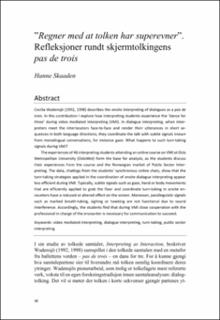"Regner med at tolken har superevner". Refleksjoner rundt skjermtolkingens pas de trois
Chapter, Peer reviewed
Published version
Permanent lenke
https://hdl.handle.net/11250/3021764Utgivelsesdato
2022Metadata
Vis full innførselSamlinger
Sammendrag
Cecilia Wadensjö (1992, 1998) describes the onsite interpreting of dialogues as a pas de trois. In this contribution I explore how interpreting students experience the ‘dance for three’ during video mediated interpreting (VMI). In dialogue interpreting, when interpreters meet the interlocutors face-to-face and render their utterances in short sequences in both language directions, they coordinate the talk with subtle signals known from monolingual conversations, for instance gaze. What happens to such turn-taking signals during VMI? The experiences of 46 interpreting students attending an online course on VMI at Oslo Metropolitan University (OsloMet) form the base for analysis, as the students discuss their experiences from the course and the Norwegian market of Public Sector Interpreting. The data, chatlogs from the students’ synchronous online chats, show that the turn-taking strategies applied in the coordination of onsite dialogue interpreting appear less efficient during VMI. Typically, subtle signals such as gaze, hand or body movements that are efficiently applied to grab the floor and coordinate turn-taking in onsite encounters have a reduced or altered effect on the screen. Moreover, paralinguistic signals such as marked breath-taking, sighing or hawking are not functional due to sound interference. Accordingly, the students find that during VMI close cooperation with the professional in charge of the encounter is necessary for communication to succeed.
